Contents
Raspberry Arched is not a very popular variety that does not have any outstanding characteristics. Nevertheless, gardeners in the Urals, Siberia, and the Far East appreciate it for its frost resistance and overall hardiness. In order to get the maximum possible yields, it is necessary to choose the right place for planting raspberries and provide them with competent care.
Inference history
Raspberry Arochnaya is a variety. It was created by a team of breeders who worked at one of the horticultural stations of the Academy of Agriculture in Novosibirsk. An application for registration in the State Register of Breeding Achievements was filed in 2000. Five years after the completion of the variety trials, Arochnaya raspberry was “officially approved”. It was recognized as the most suitable for cultivation in Eastern and Western Siberia.
Description of raspberry varieties Arochnaya
Raspberry Arochnaya is a variety known mainly to Ural and Siberian gardeners. They appreciate it, rather, for reliability and “stability” than for outstanding performance.
Berries
Raspberries are medium-sized (average weight – 2,8 g, individual specimens – up to 5 g), regular cone-shaped, with a glossy thin skin. It is quite dense, which provides the crop with good transportability and keeping quality up to 3-5 days.
The pulp is not too dense, with a noticeable raspberry flavor. The taste is balanced, sweet and sour, professional tasters rated it at 4,7 points with a maximum of five.
The purpose of the berries is universal. Arched raspberries can be eaten fresh, used as “raw materials” for homemade preparations, dried. Only for freezing, it is not very suitable – after defrosting, the berries almost lose their taste and aroma, blur into an unappetizing gruel.
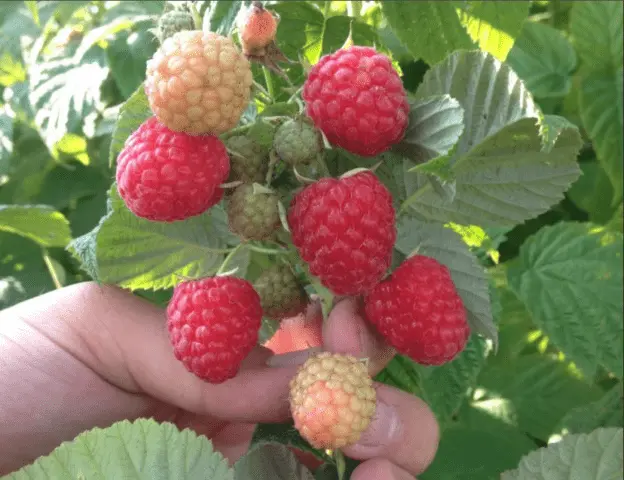
Arched raspberry drupes are firmly linked to each other, the seeds are small
Bush
Raspberry Arochnaya forms sprawling, powerful bushes 1,5-2 m high. The branches along the entire length are often dotted with sharp large spikes. The foliage of the raspberry bush is arched medium. Leaves of a typical size and shape for the culture, with a slightly “wrinkled” front side and a rare “edge” on the wrong side.
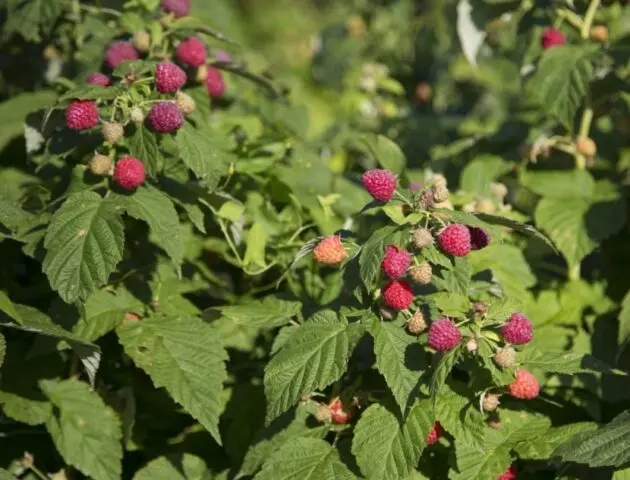
Initially upright shoots of raspberry Arch gradually bend in an arc, but retain their shape under the weight of berries
Characterization
Since the Arochnaya raspberry was created specifically for Siberia and other regions with a harsh climate, its main characteristic, which ensures the demand for the variety among gardeners, is cold resistance. Culture cannot “boast” of other outstanding indicators.
Ripening time and yield of raspberries Arched
Raspberry Arochnaya is a mid-season variety. It takes 70-75 days from bud break to harvest. But depending on the weather in summer, the berries can ripen in the first decade of July, and towards the end of this month.
With proper care and good weather, about 1,5 kg of berries can be harvested from a raspberry bush per season. When grown on an industrial scale, this figure is 57,4 centners per hectare
Frost resistance
The raspberry variety is characterized by extreme cold resistance. Even without shelter, when the temperature drops to -45 ° C in winter, it freezes at a level of 1,5 points and lower, with a maximum of ten points. During the next season, the bush recovers quickly enough.
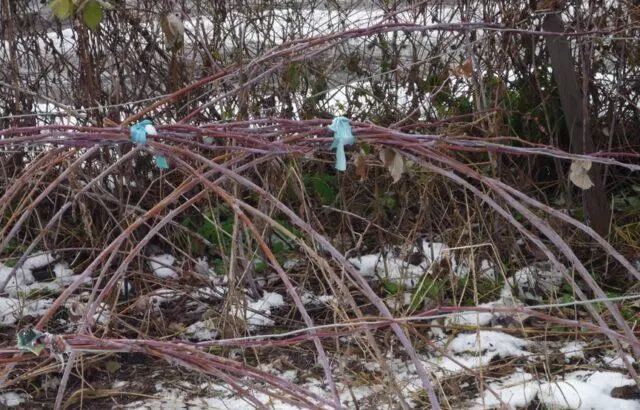
Given the high cold resistance of Arochnaya raspberry, many gardeners do not cover it for the winter, simply by removing the shoots from the trellis
Resistance to diseases
Gardeners with experience in growing Arochnaya raspberries claim that the variety resists pathogenic microflora and pest attacks very well, although it does not have “innate” immunity to any disease. The percentage of susceptibility to diseases and damage by insects is estimated by experts at 10-30%. Such a difference is easily explained by weather conditions that favor or hinder the development of the pathogen and the activity of pests.
Advantages and disadvantages
Raspberry Arched is quite suitable for use in landscape design. The bushes on the trellises look very decorative and can be used for zoning the site. In addition, it is much easier to harvest from them, given the strong thorniness of the shoots.
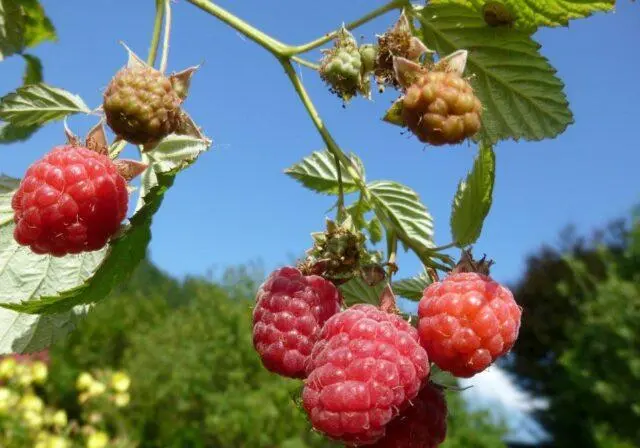
The sugar content in Arochnaya raspberries is practically “balanced” by acidity (9,1% vs. 9%)
Pros:
- frost resistance sufficient for any region;
- good resistance to diseases and pests;
- stable fruiting, which is little affected by the vagaries of the weather;
- balanced taste of berries, highly appreciated by experts;
- transportability and keeping quality are above average for the culture;
- the versatility of the appointment of berries.
Cons:
- large size and sprawling raspberry bush;
- shoots densely dotted with sharp thorns.
Features of growing raspberries Arched
Raspberry Arched is distinguished by general endurance and unpretentiousness in care. But in order to harvest annually, you need to choose the right place for planting and familiarize yourself with the general rules for caring for it.
Planting raspberries Arched
In regions with a temperate and more severe climate, Arochnaya raspberries are planted in late May or early June, when it can almost certainly be said that there will be no return frosts.
Ideally, a place for planting raspberries should meet several criteria:
- good illuminance;
- fertile but loose soil;
- neutral or slightly acidic pH;
- groundwater at least 1,5 m below the soil surface.

In partial shade and shade, the yield of Arochnaya raspberries and the quality of berries are noticeably reduced
The depth and diameter of the planting pit for raspberries Arched is 40-45 cm. It is dug and filled with nutrient soil mixture in advance, allowing it to “stand” for 2-3 weeks. The interval between adjacent bushes is at least a meter, the row spacing is 1,5-1,8 m.
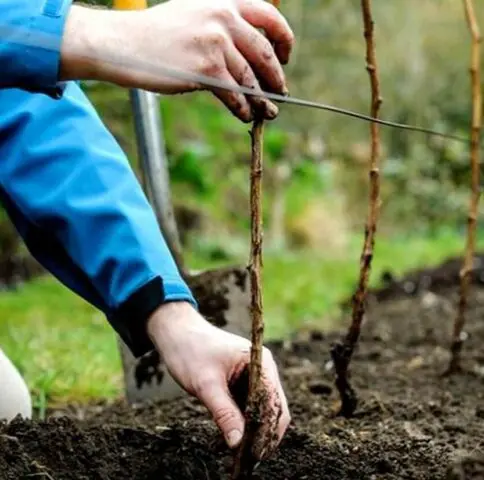
Before planting Arched raspberries, it is necessary to install a trellis about 1,5 m high
Raspberry Care Arched
Arched raspberry care – these are only standard activities:
- Watering. The substrate is moistened every 5-6 days, spending 10-15 liters per adult raspberry bush. In the heat, water about twice as often.
- Loosening, weeding. If immediately after planting the bed is mulched, there is no need for these activities. Otherwise, the soil is loosened, while getting rid of weeds, 2-3 times a month, the next day after watering.
- Application of fertilizers. Every 2-3 years in the spring, to maintain the fertility of the soil, humus is scattered over the bed, embedding it in the soil. In the “green cone” phase, mineral nitrogen fertilizers are applied. Then, at the stage of budding, the formation of ovaries and 2-2,5 weeks before harvesting – special preparations for fruit-bearing shrubs or raspberries. Approximately in the middle of October – “autumn” fertilizer containing mainly potassium and phosphorus.
- Pruning. Shoots begin to shorten for the 3-4th season after planting raspberries in the ground. In autumn, they get rid of the oldest branches (from 3-4 years old), shorten the rest by 15-20 cm and thin out the bush. In the spring they are limited to sanitary pruning.
- Preparing for winter. After clearing the bed of debris and updating the layer of mulch, Arched raspberries are removed from the support, the shoots are bent to the ground if possible. Arcs are installed above them, 2-3 layers of burlap or covering material are pulled onto the frame. On top of the entire structure, it is recommended to throw spruce branches, straw and snow.

During the active growing season, you can only remove unwanted root shoots
Reproduction
Any vegetative method is suitable for propagation of Arched raspberries. Gardeners mainly use root shoots and root cuttings for this. The survival rate of new specimens is good – 85-90%.
Transplantation of “offspring”
Raspberry Arochnaya actively forms basal shoots. Lignified specimens are transplanted in early September, green – at the end of May or June. Saplings are dug out, trying not to damage the root system, along with a clod of soil. They are immediately transferred to a permanent place.
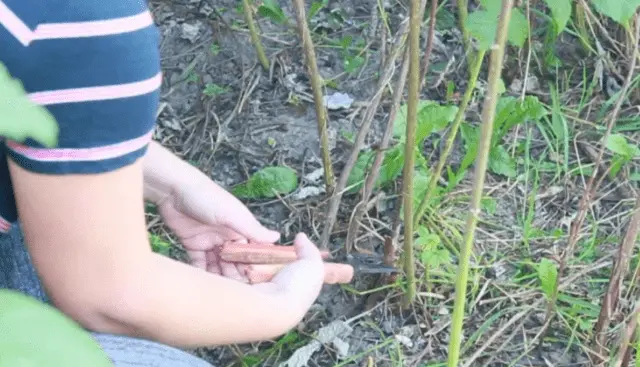
Choose “offspring” 15-20 cm high, located at least 30 cm from the “mother” bush
Using root cuttings
To obtain planting material in the spring, the soil is dug up at a distance of 30-40 cm from the raspberry bush, several adventitious roots are cut off with a thickness of 2 mm or more. They are divided into parts 8-10 cm long with 2-3 growth buds, keeping smaller roots.
Root cuttings are planted in fertile light soil in a greenhouse or greenhouse, deepening by 5-7 cm. During the summer they are watered, fertilized, loosened and weeded. In autumn, seedlings can be transferred to the garden.
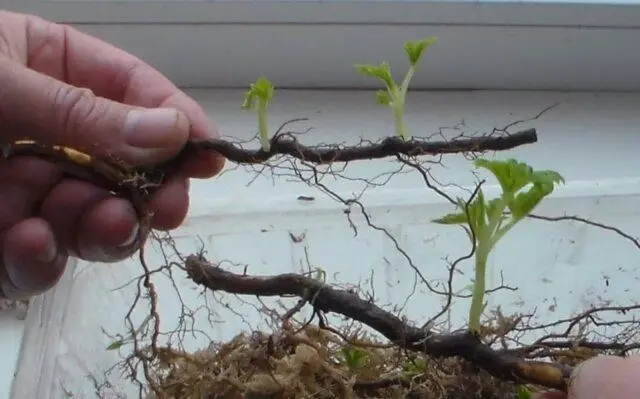
Propagation of raspberries by root cuttings is practiced if the aerial part of the bush is infected with pathogenic microflora
Prevention of diseases and pests
Raspberry Arched has a good immunity. Often, she manages to avoid infection, even if the pathogenic microflora attacks bushes of other varieties planted nearby. However, when summers are cold and rainy, powdery mildew or gray mold can develop.
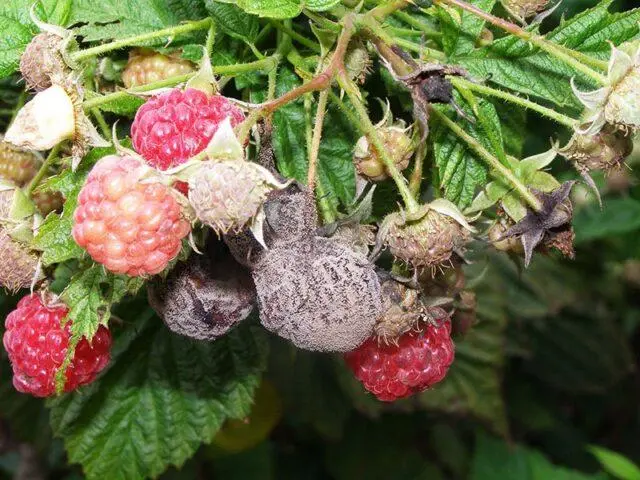
Berries affected by gray rot are unsuitable for food
To prevent fungal diseases, Arochnaya raspberries and the soil under the bushes are sprayed with any fungicides in mid-April and late October. They are also used, having found characteristic symptoms.
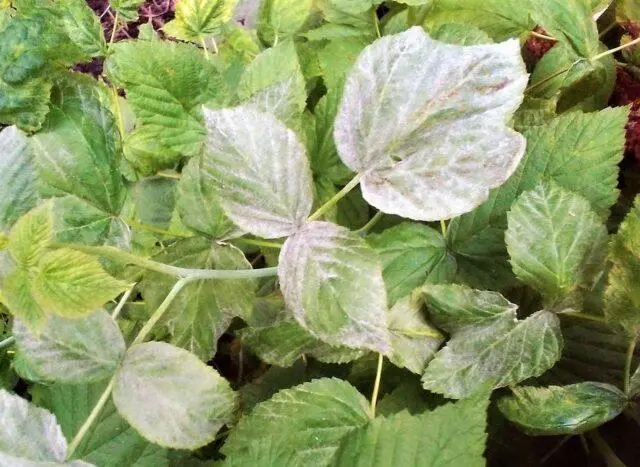
A greyish-white powdery coating, characteristic of the initial stage of infection with powdery mildew, gradually darkens and thickens.
Pests do not particularly distinguish the Arched raspberry variety. Most often, gardeners note the attack of the raspberry stem fly. Its larvae (small, off-white “worms”) eat away the shoots from the inside, they turn black and die. For prevention during the mass summer in May, the bushes are sprayed 2-3 times with insecticides (Iskra-Bio, Aktara, Konfidor-Maxi). They also help to get rid of the pest.

Before treating the bushes with insecticides, it is necessary to cut off all the shoots affected by the raspberry stem fly.
Conclusion
Raspberry Arochnaya is an “average” variety without outstanding advantages and serious shortcomings. It is distributed mainly in regions considered “risk farming zones”, where gardeners appreciate it for its frost resistance. The variety can be called undemanding in care, the bushes consistently bring good yields, they rarely get sick.









